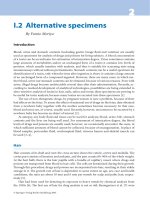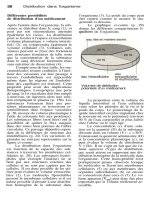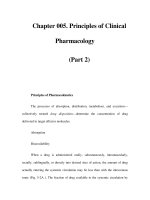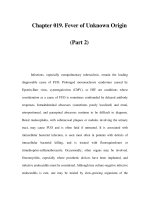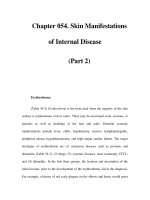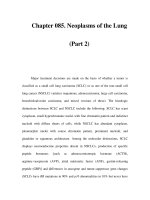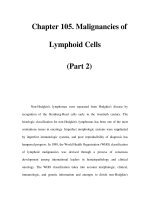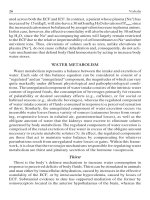Atlas of Neuromuscular Diseases - part 2 ppt
Bạn đang xem bản rút gọn của tài liệu. Xem và tải ngay bản đầy đủ của tài liệu tại đây (669.8 KB, 46 trang )
42
Regeneration after trauma:
May be aberrant and posttraumatic innervation may cause erroneous innerva-
tion of adjacent muscles.
Others causes:
Migraine:
Ophthalmoplegic migraine
Pediatric oculomotor lesions:
Congenital, traumatic, and inflammatory causes are most common.
Fasting glucose
Imaging, especially to exclude aneurysm
Botulism (pupils)
Brainstem disorders and Miller Fisher Syndrome
Congenital lesions
Hereditary conditions
Myopathy – chronic progressive external ophthalmoplegia
Myasthenia Gravis
Long duration of defects may require prism therapy or strabismus surgery.
Depends on the treatment of the underlying pathology. If the lesion is of
vascular etiology, resolution occurs usually within 4–6 months.
Jacobson DM (2001) Relative pupil-sparing third nerve palsy: etiology and clinical vari-
ables predictive of a mass. Neurology 56: 797–798
Keane JR (1983) Aneurysms and third nerve palsies. Ann Neurol 14: 696–697
Kissel JR, Burde RM, Klingele TG, et al (1983) Pupil sparing oculomotor palsies with
internal carotid-posterior communicating aneurysms. Ann Neurol 13: 149–154
Richards BW, Jones FRI, Young BR (1992) Causes and prognosis in 4278 cases of paralysis
of oculomotor, trochlear and abducens cranial nerve. Am J Ophthalmol 113: 489–496
Diagnosis
Differential diagnosis
Therapy
Prognosis
References
43
Trochlear nerve
Qualities
Anatomy
Topographical
localization of lesion
Symptoms
Signs
Pathogenesis
Somatic motor to the superior oblique muscle.
The trochlear nucleus is located in the tegmentum of the midbrain at the
inferior colliculus, near the midline and ventral to the aqueduct. Axons leave
the nucleus and course dorsally around the aqueduct and decussate within the
superior medullary velum (thus, each superior oblique muscle is innervated by
the contralateral trochlear nucleus). The axons exit from the midbrain on its
dorsal surface and travel around the cerebral peduncle, emerging between the
posterior cerebral and superior cerebellar arteries with the oculomotor nerve.
The trochlear nerve pierces the dura at the angle between the free and attached
borders of the tentorium cerebelli. It then enters the lateral wall of the cavern-
ous sinus, along with the ophthalmic nerve (V1), CN III, and sometimes the
maxillary nerve (V2). It enters the superior orbital fissure, passes above the
tendinous ring, crossing medially along the roof of the orbit, then diagonally
across the levator palpebrae. The nerve breaks into three or more branches as
it enters the superior oblique muscle.
Lesion sites include the midbrain, subarachnoid space, cavernous sinus, supe-
rior orbital fissure, or orbit.
Patients experience vertical diplopia that increases when the gaze is directed
downwards and medially.
The affected eye is sometimes extorted (although this may not be apparent to
the observer) and exhibits poor depression during adduction. Hypertropia may
occur if the weakness is severe.
Isolated lesion of the trochlear nerve is rare, although it is the most common
cause of vertical diplopia. More often trochlear nerve dysfunction is observed
in association with lesions of CN III and CN VI.
Metabolic:
Diabetes
Vascular:
Hypertension
Subarachnoid hemorrhage
Genetic testing NCV/EMG Laboratory Imaging Biopsy
++
44
Uncertain: microvascular infarction
Vascular arteriosclerosis, diabetes (painless diplopia)
Infection:
Mastoiditis
Meningitis
Inflammatory:
Ophthalmoplegia or diplopia associated with giant cell arteritis
Compression:
Cavernous sinus, orbital fissure lesions
Inflammatory aneurysms ( posterior cerebral artery, anterior superior cerebellar
artery)
Trauma:
Head trauma causing compression at the tentorial edge
Lumbar puncture or spinal anesthesia
Surgery
The trochlear nerve is the most commonly injured cranial nerve in head
trauma.
Neoplastic:
Carcinomatous meningitis
Cerebellar hemangioblastoma
Ependymoma
Meningioma
Metastasis
Neurilemmoma
Pineal tumors
Trochlear nerve sheath tumors
Others:
Superior oblique myokymia
Pediatric: congenital, traumatic and idiopathic are the most frequent causes.
Diagnosis can be facilitated by the Bielschowsky test:
1. Hypertropia of the affected eye
2. Diplopia is exacerbated when the affected eye is turned nasally
3. Diplopia is exacerbated by gazing downward
4. Diplopia is improved by tilting the head away from the affected eye
Also, when viewing a horizontal line, the patient sees two lines. The lower line
is tilted and comes closest to the upper line on the side towards to the affected
eye.
Subtle diagnosis: “Cross over” or Maddox rod techniques
Skew deviation, a disparity in the vertical positioning of the eyes of supra-
nuclear origin, can mimic trochlear palsy. Myasthenia gravis, disorders of the
extraocular muscles, thyroid disease, and oculomotor palsy that affects the
superior rectus can also cause similar effects.
Diagnosis
Differential diagnosis
45
The vertical diplopia may be alleviated by the patching of one eye or the use of
prisms. Surgery could be indicated to remove compression or repair trauma.
The recovery rate over 6 months was observed to be higher in cases of diabetic
etiology than other non-selected cases.
Berlit P (1991) Isolated and combined pareses of cranial nerves III, IV, and VI. A retrospec-
tive study of 412 patients. J Neurol Sci 103: 10–15
Jacobson DM, Marshfield DI, Moster ML, et al (2000) Isolated trochlear nerve palsy in
patients with multiple sclerosis. Neurology 55: 321–322
Keane JR (1993) Fourth nerve palsy: historical review and study of 215 inpatients. Neurol-
ogy 43: 2439–2443
Rush JA, Younge BR (1981) Paralysis of cranial nerves III, IV, and VI. Arch Ophthalmol 99:
76–79
Therapy
Prognosis
References
46
Trigeminal nerve
Genetic testing NCV/EMG Laboratory Imaging Biopsy
++++
Somatosensory evoked potentials
Reflexes: masseteric, corneal
reflex, EMG
Fig. 4
.
a
1
Mandibular nerve,
2
Inferior alveolar nerve,
3
Men-
tal nerve. b
1
Temporal muscle,
2
Masseteric muscle,
3
ptery-
goid muscles.
47
Fig. 7.
1
Maxillary nerve,
2
Tri-
geminal ganglion,
3
The maxil-
la (bone removed),
4
Branch of
superior alveolar nerve
Fig. 6
. 1
Ophthalmic nerve,
2
Optic nerve,
3
Trigeminal gan-
glion,
4
Ciliary ganglion
Fig. 5
. 1a
Ophthalmic nerve,
2a
Maxil|ary nerve,
3a
Mandib-
ular nerve,
1b–3b
Sensory dis-
tribution
48
Qualities
Branchial motor: mastication, tensor tympani muscle, tensor veli palatini mus-
cle, myohyoid muscle, anterior belly of digastric muscle.
General sensory:
Face, scalp, conjunctiva, bulb of eye, mucous membranes of paranasal sinus,
nasal and oral cavity, tongue, teeth, part of external aspect of tympanic mem-
brane, meninges of anterior, and middle cranial fossa.
The trigeminal nuclei consist of a motor nucleus, a large sensory nucleus, a
mesencephalic nucleus, the pontine trigeminal nucleus, and the nucleus of the
spinal tract. The nerve emerges from the midlateral surface of the pons as a
large sensory root and a smaller motor root. It ascends over the temporal bone
to reach its sensory ganglion, the trigeminal or semilunar ganglion. The bran-
chial motor branch lies beneath the ganglion and exits via the foramen rotun-
dum. The sensory ganglion is located in the trigeminal (Meckle’s) cave in the
floor of the middle cranial fossa. The three major divisions of the trigeminal
nerve, ophthalmic nerve (V1), maxillary nerve (V2), and mandibular nerve (V3),
exit the skull through the superior orbital fissure, the foramen rotundum and the
foramen ovale, respectively. V1 (and in rare instances, V2) passes through the
cavernous sinus (see Fig. 4 through Fig. 7).
Fig. 8. Some features of trigem-
inal neuropathy: A Motor lesion
of the right trigeminal nerve.
The jaw deviates to the ipsilater-
al side upon opening the
mouth. B Left ophthalmic
zoster. C The patient suffers
from trigeminal neuralgia.
Shaving above the mouth in-
duces attack. Note the unshav-
ed patch, that corresponds to
the area, where the attack is
elicited
Anatomy
49
The extracranial pathway has three major divisions:
1. V1, the ophthalmic nerve:
The ophthalmic nerve is positioned on the lateral side of the cavernous
sinus, and enters the orbit through the superior orbital fissure. It has three
major branches, the frontal, lacrimal, and nasociliary nerves. Intracranially,
V1 sends a sensory branch to the tentorium cerebelli.
The frontal nerve and its branches can be damaged during surgery and
fractures .
2. V2, the maxillary nerve:
The maxillary nerve has three branches: the infraorbital, zygomatic, and
pterygopalatinal nerves. It passes below the cavernous sinus and gives off
some meningeal branches.
Lesions: V2 is most frequently affected in trauma. Sensory loss of cheek and
lip are common symptoms. V2 can also be injured during facial surgery.
3. V3, the mandibular nerve:
The mandibular nerve’s major branches are the auriculotemporal, inferior
alveolar, and lingual nerves. A separate motor division innervates the mas-
seteric muscles and the tensor tympani and veli palatini muscles. The
mandibular nerve also has meningeal branches.
Lesions of the V3 may result from dentistry, implantation, mandible resec-
tion, hematoma of lower lip, or bites.
The symptoms of trigeminal nerve lesions are predominantly sensory and rarely
motor. Pain in the distribution of the trigeminal nerve can vary widely from
symptomatic pain to neuralgia.
Sensory loss can be demonstrated by sensory examination of all qualities. The
corneal reflex may be absent. Complete sensory loss, or loss of pain and
temperature, may lead to ulcers on the skin, mucous membranes and the
cornea. Sensory lesions in trigeminal nerve distribution may be also caused by
central lesions and follow an “onion skin” pattern (Fig. 8B, C). Some neuralgic
trigeminal pain syndromes may be associated with redness of the eye or
abnormal tearing during the attack.
Motor lesions are rarely symptomatic and could cause a mono- or diplegia
masticatoria. When the patient’s mouth is opened widely, the jaw will deviate
to the affected side (Fig. 8A).
Toxic:
Trichloroethylene (TCE)
Vascular:
Medullary infarction may cause trigeminal sensory deficits (e.g. “onion skin”
distribution) and pain.
Infectious:
Herpes zoster ophthalmicus: may rarely be associated with corneal ulcer,
iridocyclitis, retinal and arterial occlusions, optic nerve lesions, and oculo-
motor nerve lesions.
Symptoms
Signs
Pathogenesis
50
Inflammatory, immune mediated:
Sensory trigeminal neuropathy subacute sensory neuropathy, sensory trigemi-
nal neuropathy (connective tissue disease), Sjögren is syndrome, scleroderma,
SLE, progressive sclerosis, mixed connective tissue disease. Characterized by
abrupt onset, usually affecting one or two branches unilaterally, numbness
(may disturb motor coordination of speech), and pain.
“Numb chin syndrome”or mental neuropathy has been described as an idio-
pathic neuropathy or resulting from mandibular metastasis.
Compressive:
Compressive lesion of the trigeminal nerve in the intracranial portion by vascular
loops (posterior inferior cerebellar artery, superior cerebellar artery, arteriovenous
malformation) is considered to be a major cause of trigeminal neuralgia.
Trauma:
Cranial fractures often cause local lesions of the supratrochlear, supraorbital
and infraorbital nerves (e.g., facial lacerations and orbital fractures). Trigeminal
injury caused by fractures of the base of the skull is usually combined with
injury to the abducens and facial nerves. Injury to the maxillary and ophthalmic
divisions results in facial numbness, and involvement of the mandibular branch
causes weakness of the mastication muscles.
Neoplastic:
“Amyloidoma”
Cholesteatoma
Chordoma
Leptomeningeal carcinomatosis may compress or invade the nerve or trigemi-
nal ganglion, either intracranially or extracranially.
Metastasis
Neuroma
Iatrogenic:
Pressure and compression of infra- and supraorbital nerves by oxygen masks
during operations. Excessive pressure during operating procedures on the
mandibular joint may affect the lingual nerve. The infraorbital nerve may be
damaged by maxillary surgery. The lingual nerve can be affected by dental
surgery (extraction of 2nd or 3rd molar tooth from the medial side, and wisdom
teeth). Bronchoscopy can rarely lead to lingual nerve damage. Also abscesses
and osteosynthetic procedures of the mandibula can affect the lingual nerve.
Clinically, patients suffer from hypesthesia of the tongue, floor of the mouth,
and lingual gingiva. Patients have difficulties with eating, drinking and taste.
Neuralgias may occur.
Others:
Association of the trigeminal nerve with polyneuropathies:
AIDP (acute inflammatory demyelinating polyneuropathies)
Amyloidosis
Diphtheria
Leprosy
Waldenstroem’s macroglobulinemia
Syphilis
Thallium neuropathies
51
Cavernous sinus lesions:
The ophthalmic nerve can be injured by all diseases of the cavernous sinus.
Neoplastic lesions can be caused by sphenoid tumors, myeloma, metastases,
lymphoma, and tumors of the nasopharynx. Typically, other cranial nerves,
particularly the oculomotor nerves, are also involved.
Gradenigo syndrome: Lesion of the apex of the pyramid (from middle ear
infection) causes a combination of injury to CN V and VI, and potentially
CN VII.
Other conditions are the paratrigeminal (“Raeder”) syndrome, characterized by
unilateral facial pain, sensory loss, Horner’s syndrome, and oculomotor motil-
ity disturbances.
Aneurysm of the internal carotid artery may also damage the cavernous sinus
accompanied by concomitant headache, diplopia and ptosis.
Trigeminal neuralgia:
Can be separated into symptomatic and the more common asymptomatic
forms.
Idiopathic trigeminal neuralgia:
Has an incidence of 4 per 100,000. The average age of onset is 52–58 years.
The neuralgia affects mostly the second and third divisions.
Clinically patients suffer from the typical “tic doloreux”. Trigger mechanisms
can vary but are often specific movements such as chewing, biting or speaking.
The neurologic examination is normal, and ancillary investigations show no
specific changes. Vascular causes, like arterial loops in direct contact of the
intracranial nerve roots, are implicated as causal factors.
Therapies include medication (anticonvulsants), decompression or lesion of the
ganglion, vascular surgery in the posterior fossa, and medullary trigeminal
tractotomy.
Symptomatic trigeminal neuralgia:
May be caused by structural lesion of the trigeminal nerve or ganglion, by
surgical procedures, tumors of the cerebellopontine angle, meningitis, and
mutiple sclerosis.
If the ophthalmic divison is involved, keratitis neuroparalytica, hyperemia,
ulcers and perforation of the cornea may result.
Diagnosis:
Neuroimaging is guided by the clinical symptoms and may include CT to detect
bony changes, and MRI to investigate intracranial and extracranial tissue
spaces.
Neurophysiologic techniques rely on sensory conduction velocities and reflex
techniques (masseteric, blink reflex). Trigeminal SEP techniques can also be
used. Motor impairment of the temporal and masseter muscles can be con-
firmed by EMG.
Blink reflex responses can be interpreted topographically.
Treatment is dependent upon the underlying cause. Neuralgias are usually
treated with drugs, and sometimes surgery. Symptomatic care is required when
protective reflexes, like the corneal reflex, are impaired and may lead to
ulceration.
Therapy
52
Benito-Leon J, Simon R, Miera C (1998) Numb chin syndrome as the initial manifestation
in HIV infection. Neurology 50: 500–511
Chong VF (1996) Trigeminal neuralgia in nasopharyngeal carcinoma. J Laryngol Otol 110:
394–396
Fitzek S, Baumgartner U, Fitzek C, et al (2001) Mechanisms and predictions of chronic
facial pain in lateral medullary infraction. Ann Neurol 49: 493–500
Huber A (1998) Störungen des N. trigeminus, des N. facialis und der Lidmotorik. In: Huber
A, Kömpf D (eds) Klinische Neuroophthalmologie. Thieme, Stuttgart, pp 632–646
Huber A (1998) Nervus trigeminus. In: Huber A, Kömpf D (eds) Klinische Neuroophthal-
mologie. Thieme, Stuttgart, pp 111–112
Iannarella AAC (1978) Funktionsausfall des Nervus alveolaris inferior (bzw. lingualis) nach
der operativen Entfernung von unteren Weisheitszähnen. Inaugural Dissertation, Freie
Universität Berlin
Kaltreider HB, Talal N (1969) The neuropathy of Sjögren’s syndrome; trigeminal nerve
involvement. Arch Intern Med 70: 751–762
Lerner A, Fritz JV, Sambuchi GD (2001) Vascular compression in trigeminal neuralgia
shown by magnetic resonance imaging and magnetic resonance angiography image
registration. Arch Neurol 58: 1290–1291
Love S, Coakham HB (2001) Trigeminal neuralgia. Pathology and pathogenesis. Brain 124:
2347–2360
Schmidt F, Malin JC (1986) Nervus trigeminus (V). In: Schmidt D, Malin JC (eds) Erkrankun-
gen der Hirnnerven. Thieme, Stuttgart, pp 124–156
References
53
Genetic testing NCV/EMG Laboratory Imaging Biopsy CSF
+ MRI
CT
Angiography
Fig. 9. Bilateral abducens nerve
paresis. Inward gaze of bulbi.
This patient suffered a fall with
subsequent head trauma
Somatic motor, innervation of lateral rectus muscle
The abducens nucleus is located in the pontine tegmentum close to the
midline, and ventral to the fourth ventricle. Axons from cranial nerve VII loop
around the abducens nucleus, forming the bulge of the fourth ventricle. Axons
from the abducens nucleus course ventrally through the pontine tegmentum to
emerge from the ventral surface of the brainstem at the junction of the pons and
the pyramid of the medulla. The nerve runs anterior and lateral in the subarach-
noid space of the posterior fossa, to piercing the dura lateral to the dorsum
sellae of the sphenoid bone. The nerve continues forward between the dura and
the apex of the petrous temporal bone. Here it takes a sharp right angle,
bending over the apex of the temporal bone to enter the cavernous sinus. The
nerve lies lateral to the carotid artery, and medial to CN III, IV, V1 and V2.
Finally, the abducens nerve enters the orbit at the medial end of the superior
orbital fissure.
Patients report binocular horizontal diplopia that worsens when looking in the
direction of the paretic lateral rectus muscle and when looking at distant
objects.
Abducens nerve
Quality
Anatomy
Symptoms
54
An isolated paralysis of lateral rectus muscle causes the affected eye to be
adducted at rest. Abduction of the affected eye is highly reduced or impossible,
while gaze to the unaffected side is normal (see Fig. 9).
Lateral rectus paralysis is the most frequently encountered paralysis of an
extraocular muscle. 80% of cases exhibit isolated paralysis of the lateral rectus,
while 20% of cases are in association with CN III or IV.
Topographically:
Nuclear: Infarction, tumor, Wernicke’s disease, Moebius and Duane’s
syndrome (rare).
Fascicular lesion: Demyelination, infarction, tumor.
Subarachnoid: Meningitis, subarachnoid hemorrhage, clivus tumor (men-
ingioma, chordoma), trauma, basilar aneurysm.
Petrous apex: Mastoid infection, skull fracture, raised ICP, trigeminal
Schwannoma.
Uncertain: Microvascular infarction, migraine
Metabolic:
Rarely diabetes
Toxic:
Vincristine therapy
Vascular:
Aneurysms of the posterior inferior cerebellar, basilar or internal carotid arteries
Infections:
CMV encephalitis
Cryptococcal meningitis
Cysticercosis
HIV
Lyme disease
Syphilis
Tuberculosis
Ventriculitis of the fourth ventricle
Inflammatory-immune mediated:
Vasculitis, sarcoidosis, systemic lupus erythematosus (SLE)
Trauma:
Fractures of the base of the skull
Neoplastic:
Abducens nerve tumor
Cerebellopontine angle tumor
Clivus tumor
Leptomeningeal carcinomatosis
Leukemia
Metastasis (base of the skull)
Congenital:
Duane’s syndrome
Signs
Pathogenesis
55
Compressive:
Lesions of the cavernous sinus (e.g. thrombosis)
Abducens palsy is a common sign of increased cranial pressure caused by:
Hydrocephalus
Pseudotumor cerebri
Tumors
Most frequent causes:
Multiple Sclerosis (MS)
Syphilis
Vascular, diabetes
Undetermined cause
Most frequent causes in pediatric cases:
Neoplasm 39%
Trauma 20%
Inflammatory 18%
Bilateral CN VI palsy:
Meningitis, AIDP, Wernicke’s encephalopathy, pontine glioma
Diagnosis is achieved by assessing the patient’s metabolic situation (DM),
imaging to exclude tumors or vascular conditions, and checking the CSF and
serology for signs of infection.
Convergence spasm
Duane’s syndrome
Internuclear ophthalmoplegia
Myasthenia gravis
Pseudo VI nerve palsy (thalamic and subthalamic region)
Thyroid disease
Treatment is dependent upon the underlying cause.
The most frequent “idiopathic” type in adults usually remits within 4–12 weeks.
Galetta SL (1997) III, IV, VI nerve palsies. In: Newman NJ (ed) Neuro-ophthalmology.
American Academy of Neurology, Boston, pp 145-33–145-50
Gurinsky JS, Quencer RM, Post MJ (1983) Sixth nerve ophthalmoplegia secondary to a
cavernous sinus lesion. J Clin Neuro Ophthalmol 3: 277–281
Lee AG, Brazis PW (2000) Neuro-ophthalmology. In: Evans RW, Baskin DS, Yatsu FM (eds)
Prognosis of neurological disorders. Oxford University Press, New York Oxford, pp 97–108
Robertson RM, Hines JD, Rucker CW (1970) Acquired sixth nerve paresis in children. Arch
Ophthalmol 83: 574–579
Rucker CW (1966) The causes of paralysis of the third, fourth, and sixth cranial nerves. Am
J Ophthalmol 62: 1293–1298
Rush JA, Younge BR (1981) Paralysis of cranial nerves III, IV and VI. Cause and prognosis
in 1000 cases. Arch Ophthalmol 99: 76–79
Diagnosis
Differential diagnosis
Therapy
Prognosis
References
56
Facial nerve
Genetic testing NCV/EMG Laboratory Imaging Clinical
exam
++ + MRI Taste
Hearing
Fig. 11
.
Facial nerve palsy: This
patient suffered from a right sid-
ed Bell’s palsy, which resulted
in a contracture of the facial
muscles. Note the deviated
mouth
Fig. 10
.
Facial nerve:
1
Posteri-
or auricular nerve,
2
Mandibu-
lar branch,
3
Buccal branch,
4
Zygomatic branch,
5
Temporal
branch,
6
Parotid gland
57
Qualities
Branchial motor
Stapedius, stylohyoid, posterior belly of disgastric, muscles of facial expression,
including buccinator, platysma, and occipitalis muscles.
Lacrimal, submandibular, sublingual glands, as well as mucous membranes of
the nose and hard and soft palate.
Skin of concha of auricle, small area of skin behind ear. Trigeminal nerve-V3
supplies the wall of the acoustic meatus and external tympanic membrane.
Taste of anterior two thirds of tongue and hard and soft palate
Large petrosal: salivation and lacrimation
Nerve to the stapedius muscle
Chorda tympani: taste
Motor branches
Sensory: ear
Branchial motor fibers originate from the facial motor nucleus in the pons,
lateral and caudal to the VIth nerve nucleus. The fibers exit the nucleus
medially, and wrap laterally around the VIth nerve nucleus in an arc called the
internal genu. The superior salivatory nucleus is the origin of the preganglionic
parasympathetic fibers. The spinal nucleus of the trigeminal nerve is where the
small general sensory component synapses. Taste fibers synapse in the rostral
gustatory portion of the nucleus solitarius. All four groups of fibers leave the
brainstem at the base of the pons and enter the internal auditory meatus. The
visceral motor, general sensory, and special sensory fibers collectively form the
nervus intermedius. Within the petrous portion of the temporal bone, the nerve
swells to form the geniculate ganglion (the site of the cell bodies for the taste
and general sensory fibers). The nerve splits within the petrous portion of the
temporal bone. First, the greater petrosal nerve carries the parasympathetic
fibers to the lacrimal gland and nasal mucosa (the pterygopalatine ganglion is
found along its course). The chorda tympani nerve exits through the petrotym-
panic fissure, and brings parasympathetic fibers to the sublingual and subman-
dibular salivary glands, as well as the taste sensory fibers to the tongue. The
nerve to the stapedius innervates the stapedius muscle. The remaining part of
the facial nerve, carrying branchial motor and general sensory fibers, exits via
the stylomastoid foramen. The motor fibers branch to innervate the facial
muscles, with many branches passing through the parotid gland (see Fig. 10).
1. Supranuclear lesion
2. Nuclear and brainstem lesions
3. Cerebellopontine angle
4. Canalis nervi facialis
5. Exit of cranial vault and peripheral twigs
Lesion of the facial nerve results predominantly in loss of motor function
characterized by acute onset of facial paresis, sometimes associated with pain
Visceral motor
General sensory
Special sensory
Major branches
Anatomy
Topographic lesions
Symptoms
58
and/or numbness around the ear. Loss of visceral function results in loss of
tearing or submandibular salivary flow (10 % of cases), loss of taste (25%), and
hyperacusis (though patients rarely complain of this).
Supranuclear: Because the facial motor nuclei receive cortical input concern-
ing the upper facial muscles bilaterally, but the lower face muscles unilaterally,
a supranuclear lesion often results in paresis of a single lower quandrant of the
face (contralateral to the lesion).
Pyramidal facial weakness: lower face paresis with voluntary motion.
Emotional: face paralysis with emotion (location: dorsolateral pons- anterior
cerebellar artery).
Pontine lesion: associated lesion of neighboring structures: nucleus of CN VI,
conjugate ocular movements, hemiparesis.
Mimic and voluntary movements of the facial muscles are impaired or absent.
Dropping of corner of mouth, lagophthalmos. Patients are unable to whistle,
frown, or show teeth. Motor function is assessed by the symmetry and degree of
various facial movements. With paralysis of the posterior belly of the disgastric,
the jaw is deviated to the healthy side. With pterygoid paralysis, the opposite is
true.
a) Internal auditory meatus: geniculate ganglion-reduced salivation and lacri-
mation. Loss of taste on anterior 2/3 of tongue. Hyperacusis.
b) Between internal auditory meatus and stapedius nerve: Facial paralysis
without impairment of lacrimation, however salivation, loss of taste and
hyperacusis.
c) Between stapedius nerve and chorda tympani: facial paralysis, intact lacri-
mation, reduced salivation and taste. No hyperacusis.
d) Distal to the chorda tympani: facial paralysis, no impairment of salivation,
lacrimation or hyperacusis.
e) After exit from the stylomastoid foramen: lesions of singular branches.
f) Muscle disease: myopathic face
Symptoms and signs depend upon the site of the lesion. Perifacial nerve twigs
can be damaged with neurosurgical procedures. Parotid surgery may damage
one or several twigs, and a paresis of the caudal perioral muscle is seen in
carotid surgery.
Prevalence 6–7/100,000 – 23/100,000. Increases with age.
Development: Paralysis progresses from 3–72 hours. About half of the patients
have pain (mastoid, ear). Some (30%) have excess tearing. Other symptoms
include dysgeusia.
Facial weakness is complete in 70% of cases.
Stapedius dysfunction occurs in 30% of cases.
Mild lacrimation and taste problems are rare.
Some patients complain of ill-defined sensory symptoms in the trigeminal
distribution.
Improvement occurs in 4–6 weeks, for about 80% (see Fig. 11).
Signs
Central lesions
Peripheral lesions
Location of peripheral
lesion
Partial peripheral
lesion
Bell’s palsy
59
Symptoms may persist and contractures or synkineses may develop.
Pathogenesis is not clear, but may be viral or inflammatory.
Associated diseases: diabetes.
Acyclovir, steroids, and surgery were compared: Results show better outcome
from steroid treated vs. non-steroid treated patients. Steroids with acyclovir are
also effective.
Surgery: 104 cases were evaluated. 71 showed complete recovery, 84% with
near nomal function.
Important additional measures to consider: eye care, eye-lid surgery, facial
rehabilitation, botulinus toxin injections for symptomatic synkineses.
Sarcoid and granulomatous disease
Infection (leprosy, otitis media, Lyme disease, Ramsay Hunt syndrome)
Neoplasm or mass
Trauma
Cardiofacial syndrome (lower lip palsy)
Polyneuropathies:
AIDP (often bilateral)
Neoplastic:
Leptomeningeal carcinomatosis
Infection:
Leprosy
Lyme disease (often bilateral)
Otitis media, acute or chronic, cholesteatoma
Ramsey Hunt syndrome
Birth trauma:
Cardiofacial syndrome
Congenital dysfunction
Hemifacial microsomia
Mobius syndrome
Prenatally: face compression aginst mother’s sacrum, abnormal posture.
Iatrogenic:
Oxygen mask used in anesthesia (mandibular branch)
Trauma:
Extracranial: parotid surgery, gunshot, knife wound, carotid endartectomy
Intratemporal: motor vehicle accidents – 70–80% from longitudinal fractures.
Intracranial: surgery.
Temporal bone fractures: In about 50% of cases of transverse temporal bone
fractures, the facial nerve within the internal auditory canal is damaged. Facial
nerve injury occurs in about 50% of cases and the labyrinth is usually damaged
by the fracture. 65% to 80% of fractures are neither longitudinal nor transverse,
but rather oblique. Severe head injury can also avulse the nerve root from the
brainstem.
Therapy
Differential diagnosis
for Bell’s palsy
Pathogenesis
60
Tumors:
Predominantly cerebellopontine angle
Acoustic neuroma
Base of the skull tumors: dermoids, large meningiomas, metastasis
Other conditions:
Infection: Botulism, Polio, Syphillis, tetanus
Heerfort syndrome
Paget’s disease
Myeloma
Porphyria
Regeneration may result in involuntary movements and similar conditions:
Blepharospasm
Contracture (postparalytic facial dysfunction) (see Fig. 11)
Facial myokymia
Hemifacial spasm
Synkinesis
Tick
Association with Polyneuropathy:
AIDP, Lyme disease, polyradiculopathies, sarcoid
Periocular weakness, without extraocular movement disturbance:
Congenital myopathies
Muscular Dystrophies: Myotonic, Facioscapulohumeral, Oculopharyngeal
Polymyositis
MND/ALS:
ALS, bulbospinal muscular atrophy, motor neuron syndromes
Bilateral facial paralysis:
AIDP
Leprosy
Lyme disease
Melkersson-Rosenthal syndrome
ALS
Moebius syndrome
Myopathies
Sarcoid
Along with the clinical examination, laboratory tests that may be helpful
include: ESR, glucose, ANA, RF, Lyme serology, HIV, angiotensin converting
enzyme (for sarcoidosis), serology, virology, microbial tests.
CSF should be examined if an intracranial inflammatory lesion is suspected.
Other tests include CT and MRI, EMG (facial nerve CMAP, needle EMG), blink
reflex and magnetic stimulation.
For Bell’s palsy, steroids and decompression may be helpful, along with sup-
portive care.
Diagnosis
Therapy
61
In Bell’s palsy, improvement typically occurs 10 days to 2 months after onset.
Plateau is reached at 6 weeks to 9 months.
Recurrence is possible in up to 10%.
Prognosis based on electrophysiologic tests:
CMAP in comparison side to side: good
Blink: uncertain
Needle EMG: limited
Qualities associated with a better prognosis for Bell’s palsy include:
Incomplete paralysis
Early improvement
Slow progression
Younger age
Normal salivary flow
Normal taste
Results of the electrodiagnostic tests
Residual signs may occur with Bell’s palsy. These include:
Synkinesis (50%)
Facial weakness (30%)
Contracture (20%)
Crocodile tears (6%)
Grogan PM, Gronseth GS (2001) Practice parameters: steroids, acyclovir and surgery for
Bell’s palsy (an evidence based review). Neurology 56: 830–836
Karnes WE (2001) Diseases of the seventh cranial nerve. In: Dyck PJ, Thomas PK, Lambert
EH, Bunge R (eds) Peripheral neuropathy. Saunders, Philadelphia, pp 1266–1299
Peitersen E (1982) The natural history of Bell’s palsy. Am J Otol 4: 107–111
Qui WW, Yin SS, Stucker FJ, et al (1996) Time course of Bell’s palsy. Arch Otolaryngol Head
Neck Surg 122: 967–972
Schmutzhard E (2001) Viral infections of the CNS with special emphasis on herpes simplex
infections. J Neurol 248: 469–477
Sweeney CJ, Gilden DH (2002) Ramsay Hunt syndrome. J Neurol Neurosurg Psychiatry 71:
149–154
Rowlands S, Hooper R, Hughes E, et al (2001) The epidemiology and treatment of Bell’s
palsy in the UK. Eur Neurol 9: 63–67
Yu AC, Sweeney PJ (2002) Cranial neuropathies. In: Katirji B, Kaminski HJ, Preston DC, Ruff
RL, Shapiro B (eds) Neuromuscular disease in clinical practice. Butterworth Heinemann,
Boston Oxford, pp 820–827
Prognosis
References
62
Special sensory: auditory information from the cochlea.
Cell bodies of afferent neurons are located in the spiral ganglia in the inner ear
and receive input from the cochlea.
The central processes of the nerve travel through the internal auditory meatus
with the facial nerve. The eighth nerve enters the medulla just at the junction of
the pons and lateral to the facial nerve. Fibers of the auditory nerve bifurcate on
entering the brain stem, sending a branch to both the dorsal and ventral
divisions of the cochlear nucleus. From here, the path to the auditory cortex is
not well understood and includes several pathways: superior olivary complex,
nuclei of the lateral lemniscus, the trapezoid body, the dorsal acoustic striae,
and the inferior colliculi.
A small number of efferent axons are found in the eighth nerve, projecting
from the superior olivary complex to the hair cells of the cochlea bilaterally.
The function of this projection is not clear.
Hearing loss predominates (slow onset or acute), possibly associated with
tinnitus.
Damage can cause hearing loss ranging from mild to complete deafness.
Metabolic:
Diabetes, hypothyroidism
Toxic
Aniline, antibiotics, benzole, carbon monoxide, chinin, cytostatic drugs, sa-
luretics, salycilate.
Infectious:
Herpes, mumps, otitis, sarcoid
Inflammatory/immune mediated:
Paraneoplastic (Anti-Hu associated) (very rare)
Compressive:
Tumors at the cerebellopontine angle
Acoustic nerve
Quality
Genetic testing NCV/EMG Laboratory Imaging Biopsy Hearing tests
Familial Auditory evoked + MRI, CT +
potentials
Anatomy
Symptoms
Signs
Pathogenesis
63
Congenital:
Thalidomide, rubeola embryopathy
Hereditary:
Congenital hearing loss
Hereditary Motor-Sensory Neuropathies: (HMSN or CMT) including:
CMT 1A
CMT 1B
Coffin-Lowry syndrome
Duane’s syndrome
Dilated cardiomyopathy with sensorineural hearing loss (CMD1J, CMD1K)
HMSN 6
Neurofibromatosis-2
Neuroaxonal Dystrophy (late infantile)
X-linked, HMSN X (Connexin 32)
Trauma:
Temporal bone fractures
Neoplastic:
Cholesteatoma, metastasis, meningeal carcinomatosis
Tinnitus:
Sensation of noise caused by abnormal excitation of acoustic apparatus (con-
tinuous, intermittent, uni- or bilateral). Tinnitus is often associated with senso-
rineural hearing loss and vertigo. Only 7% of patients with tinnitus have normal
hearing.
Causes: conducting apparatus, hemifacial spasm, ischemia, drugs; quinine,
salycilates, streptomycin, amyl nitrate, labyrinthitis, arteriosclerosis, otosclero-
sis, degeneration of cochlea.
Diagnosis is made by hearing tests and auditory evoked potentials (AEP),
genetic testing for known deafness genes, and imaging for traumatic or neoplas-
tic causes.
Tonn JC, Schlake HP, Goldbrunner R, et al (2000) Acoustic neuroma surgery as an
interdisciplinary approach; a neurosurgical series of 508 patients. J Neurol Neurosurg
Psychiatry 69: 161–166
Vernon J (1984) Tinnitus. In: Northern JL (ed) Hearing disorders. Little Brown, Boston
Diagnosis
References
64
Special sensory: balance information from the semicircular canals
The vestibular apparatus consists of the saccule, the utricle and the semicircular
canals. The semicircular canals perceive angular movement of the head in
space. The saccule and utricle perceive the position of the head with respect to
gravity.
Hairy cells within the apparatus synapse with peripheral processes of the
primary sensory neurons, whose cell bodies constitute the vestibular ganglion.
Central processes from the vestibular ganglion cells form the vestibular part of
the VIII nerve. The nerve runs with the cochlear division and the VII nerve
through the internal acoustic meatus and terminates in the vestibular nuclear
complex at the floor of the fourth ventricle. A limited number of axons termi-
nate in the flocculonodular lobe of the cerebellum.
The secondary sensory neurons, whose cell bodies form the vestibular
nuclei, send axons mainly to the cerbellum and lower motor neurons of brain
stem and spinal cord (modulating muscle activation for keeping balance).
In the lateral vestibular nucleus, axons project ipsilateral and caudal into the
spinal cord and vestibulospinal tract (to lower motor neurons for the control of
antigravity muscles).
The medial and inferior vestibular nuclei have reciprocal connections with
the cerebellum (vestibulocerebellar tract), which allows the cerebellum to
coordinate balance during movement. All nuclei in the vestibular complex
send fibers into the medial longitudinal fasciculus (MLF), which serves to
maintain orientation in space. Connections between CN III, IV, and VI allow the
eyes to fixate on an object while the head is moving. Vestibular axons in the
descending part of the MLF are referred to as the medial vestibulospinal tract,
and influence lower motor neurons in the cervical spinal cord bilaterally.
Patients experience dizziness, falling, vertigo, and nausea/vomiting.
Lesions result in abnormal eye movements, and problems with stance, gait, and
equilibrium.
Metabolic:
Diabetes, uremia
Vestibular nerve
Quality
Anatomy
Symptoms
Signs
Pathogenesis
Genetic testing NCV/EMG Laboratory Imaging Biopsy
Posturometry + MRI
Vestibulometry
65
Toxic:
Alcohol
Aminoglycosides
Cytostatic drugs: cisplatin, cyclophosphamide, hydroxurea, vinblastine
Heavy metals
Lead
Mercury
Quinine, salicylates
Vascular:
Anterior inferior cerebellar artery (AICA)
Posterior communicating artery aneurysm
Unruptured aneurysms, large vascular loops
Vascular lesions of the spiral ganglion
Vertebrobasilar circulation (history of hypertension, diabetes)
Infection:
Labyrinthitis: specific and unspecific: Suppuration reaches inner ear by either
blood, or direct invasion (meningoencephalitis).
Bacterial: streptococcus pneumoniae, hemophilus
Syphilis
Lyme disease
Petrositis
Viral:
Ramsey Hunt syndrome
Herpes zoster oticus
Vestibular neuronitis
HIV may cause sensoneurial hearing loss
Mycotic:
Coccidiomycosis, cryptococcosis
Rickettsial infection
Immunologic disorders:
Hashimoto’s thyroiditis
MS, leukodystrophies,
Demyelinating neuropathies
Periarteritis nodosa
Sarcoidosis
Trauma
Blunt-, penetrating-, or barotrauma
Transverse fractures are often associated with CN VII lesion. The less common
transverse fractures damage both facial and vestibulocochlear nerves. These
fractures involve the otic capsule, passing through the vestibule of the inner ear,
tearing the membranous labyrinth, and lacerating both vestibular and cochlear
nerves.
Vertigo is the most common neurological sequel to head injury and it is
positional.
66
Neoplastic:
Acoustic nerve neuroma, Schwannoma, metastases, NF
Others:
Hyperviscosity syndromes (polycythemia vera, hypergammaglobulinemia,
Waldenstroem’s macroglobulinemia)
Vestibular neuropathy
Cupulolithiasis (benign paroxysmal positional nystagmus)
Psychogenic
Congenital and hereditary:
Aplasia
Degeneration after development of the cochlea:
Hereditary, sensorineural deafness
Degeneration with other defects:
Arnold Chiari
Atrophy of CN VIII
Cockayne syndrome
Goiter
Hallgren’s syndrome
Kearns Sayre syndrome
Pigmentary Waardenburg syndrome
Refsum’s disease
Retinitis pigmentosa
Diagnosis is based on vestibular testing, laboratory testing (including genetics
for hereditary causes), and imaging (for trauma, etc.).
Kovar M, Waltner JG (1971) Radiation effects on the middle and inner ear. Pract Otorhino-
laryng 33: 233–242
Luxon LM (1993) Diseases of the eighth cranial nerve. In: Dyck PJ, Thomas PK, Griffin JP,
Low PA, Podusl JF (eds) Peripheral neuropathies. Saunders, Philadelphia, pp 836–868
Scherer H (1986) Nervus vestibulocochlearis. In: Schmidt D, Malin JC (eds) Erkrankungen
der Hirnnerven. Thieme, Stuttgart, pp 186–218
Diagnosis
References
